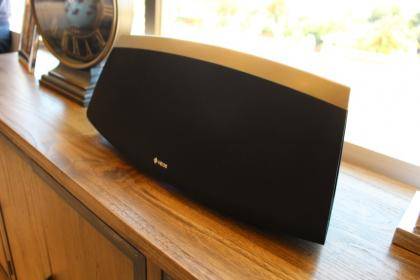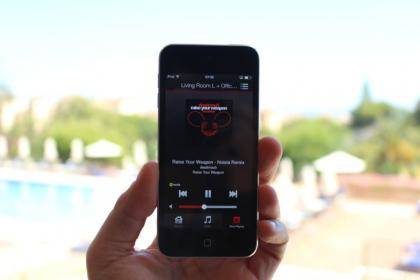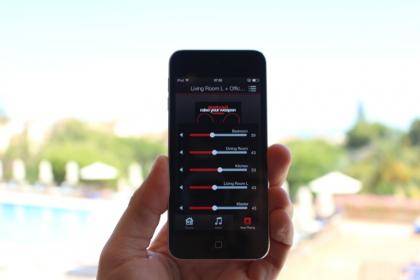December 02,2021
Denon Heos 3, Heos 5 and Heos 7 multi-room wireless speakers review
by Jennifer Cameron inMediterranean Style
Denon has big plans for multi-room audio, having launched the Heos wireless speaker system at its annual dealer conference with a selection of models designed to compete directly with big names like Sonos. We got the chance to listen to the entire range and put the smartphone app through its paces to see whether the company has done enough to put a speaker in every room of your home.
The Basics Heos is a Wi-Fi based multi-room system comprised of three speakers (the Heos 3, Heos 5 and Heos 7), the Heos Link pre-amp for turning your existing Hi-Fi or AV receiver into a Heos zone, and the Heos Amp amplifier for giving any set of stereo speakers wireless capabilities. Rather than set up a mesh network a la Sonos, Heos uses your existing Wi-Fi network to get connected, with support for dual-band 5GHz 802.11n for the best possible connection.

The unique curved shape, matt black finish and silver metal accents on each speaker gives the Heos range a sleek, high-end look that certainly gives it an edge over the colourful Pure Jongo multi-room system, but if you aren’t a fan of the dark colour scheme we’ve been told to expect a silver and white variant of every speaker in the range in the future. Denon also plans to add new features with quarterly firmware updates, meaning Heos speakers could soon double as Wi-Fi repeaters, strengthening your home's wireless network signal automatically.
Heos smartphone apps We got to try an in-development version of the iOS app, but an Android version should be arriving on the Google Play store in time for launch. After using the app to set up your first Heos speaker, it automatically shares your Wi-Fi details with every additional speaker to make setup as simple as possible.

As well as playing music directly from your smart device, either as one song to multiple speakers or multiple songs to multiple speakers, the app ties in with your Spotify, Deezer, Napster and Pandora accounts for internet streaming. The main screen only displays the accounts you use, keeping the others hidden from view. All streaming service login information is saved to the cloud, meaning you won't have to add usernames and passwords when moving to a new smartphone or buying a tablet. Unfortunately you can't copy playlists from Spotify into the app, meaning you'll have to create new ones.

Heos can also play files from any networked PC or NAS device, and queue up tracks from multiple sources for streamlined playback. Finally, anyone with a Heos app can add their own tracks to the centralised queue, letting anyone become the DJ at a party.

Although it's possible to play something different on every speaker in a Heos setup, it's incredibly simple to sync them all together for simultaneous playback. The list of speakers on the main screen can be pinched together to automatically group them, with the speaker at the top of the list sharing its currently playing track or source with the rest of the system. Another tap can separate them just as quickly.
However you choose to play your music, you get independent volume control over every speaker in a system. Once set to specific levels, the master volume will maintain your settings as you adjust the overall system volume.
Heos 3 - £299 The entry-level Heos 3 is the most compact speaker in the range, but still packs a punch thanks to a two channel digital amplifier, twin full-range speaker drivers and a bass port for low-end grunt. It is best suited to smaller rooms, but is flexible in terms of placement thanks to a built-in wall mount screw and vertical or horizontal placement. It can also be set up in a stereo pair, either as dedicated music speakers or in front of a TV to improve on your flatscreen's integrated drivers.
Like the rest of the range, the Heos 3 has a 3.5mm auxiliary input and USB port on the back of the speaker for connecting wired devices or playing music from a flash drive. Once plugged in, the speaker indexes the disk and makes all the music available for playback on any speaker in the system - not just the one you've plugged your flash drive in to.
Played in isolation, the Heos 3 is surprisingly powerful given its size. We heard a selection of tracks from a range of different genres, and although bass was predictably weaker than the larger models the mid-range and high-end punched far above its weight. Set up as a stereo pair, the sense of spacial impression was also enough to rival a set of bookshelf or small floor-standing speakers.
Heos 5 - £349 Stepping up the range, the mainstream Heos 5 is twice the size of the Heos 3 and includes four class D amplifiers, two tweeters, two mid-range drivers and a passive bass radiator. It's small enough to squeeze onto a bookshelf
Played solo, the Heos 5 produces a louder, more balanced sound than the Heos 3. All three speakers have a very similar tone, sounding warm and punchy regardless of musical genre. The Heos 5 should easily fill larger rooms, so is best suited to bedrooms and reception rooms whereas the Heos 3 is ideal for bathrooms, kitchens and smaller areas.
Heos 7 - £399 The flagship HEOS 7 is the largest model in the range, with five class D amplifiers powering two tweeters, two mid-range drivers, a subwoofer and twin bass radiators. It's huge, so is best placed on a sideboard or coffee table, but it more than justifies its dimensions with its sound quality.
By itself, the Heos 7 easily makes itself heard - it could fill a room in isolation, with a rich tone and plenty of low-end muscle from the twin bass radiators. It is the most striking of the three speakers, thanks to the curved shape and the strip of metal trim capping the top. Despite the larger size, it has the same number of inputs as the Heos 3, meaning USB, 3.5mm auxiliary and an Ethernet port, should you prefer a wired network to wireless.
Heos Amp - £299/ Heos Link - £399 If you have a pair of bookshelf or floor-standing speakers, you can turn them into a Heos zone with the Heos Amp. It has Denon digital amplification for up to 2x 100w RMS of audio muscle, along with a subwoofer output for adding a more powerful low end.
The Amp also has analog, USB and digital optical inputs for connecting a TV, external hard disk or older analogue device to the Heos network. You can toggle between each input using the smartphone app, and each one is digitised and distributed to the rest of the system.
The Heos Link, meanwhile, turns your existing Hi-Fi or AV receiver into a Heos zone. It has analogue, optical and digital coaxial audio outputs as well as the same set of USB, analogue and optical inputs, meaning you should be able to connect any home cinema kit and turn it into a multi-room zone. A 12v trigger and an IR output can also be used to control legacy devices.
Neither the Amp nor the Link are particularly attractive, with a mix of black and silver plastics, but they don't need to be on display so it certainly isn't a deal-breaker. If you have invested in high-quality audio kit they are an excellent way to add it to a multi-room system.
Putting it all together With multiple Heos products in a system, we were impressed by the balance across the varying speaker sizes and its ability to completely surround you with music. You'll need a big budget to fill a room with multiple units, but with careful placement you could put sound in every room of a house with only a few speakers.
Latency is critical with multi-room streaming, as a slight variance in timing can ruin how a system sounds. With Heos, this is a non-issue when streaming MP3s - Denon says there is absolutely no latency at all when running on a 5GHz Wi-Fi network. Latency only rises to 0.4 milliseconds when playing high bitrate FLAC and lossless files, meaning there's no perceptible difference when moving from one speaker to another.
We were a little surprised that Heos doesn't include Bluetooth. A Denon rep told us it would be possible to add a Bluetooth receiver to a Heos setup, but it's a shame this isn't included as standard. The blue activity LED on every Heos product is also incredibly bright, and there's currently no way to dim or disable it, although we were told this would be coming in the future. The bigger issue is price; Denon is going up against the might of Sonos, but each Heos speaker costs around £50 more than the equivalent Sonos product. Even with the "90 days to be amazed" campaign, which will give Heos customers a 20% discount on their second product when bought within 90 days of a first, it looks expensive for an untested system.
Even with these concerns, however, we walked away from our preview impressed. Whether Heos can take on the likes of Sonos remains to be seen, especially as Denon isn't exactly competing on price, but for a first attempt at multi-room we could find very few flaws in the app, accessories or the speakers themselves.
The Heos range should launch in the UK from August onwards. We'll hopefully have a full review a little closer to release.
